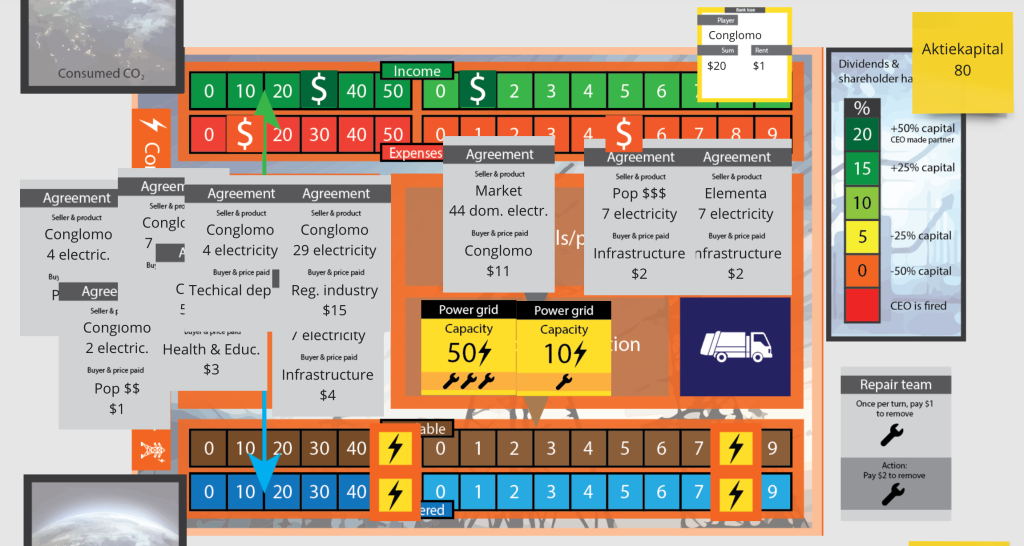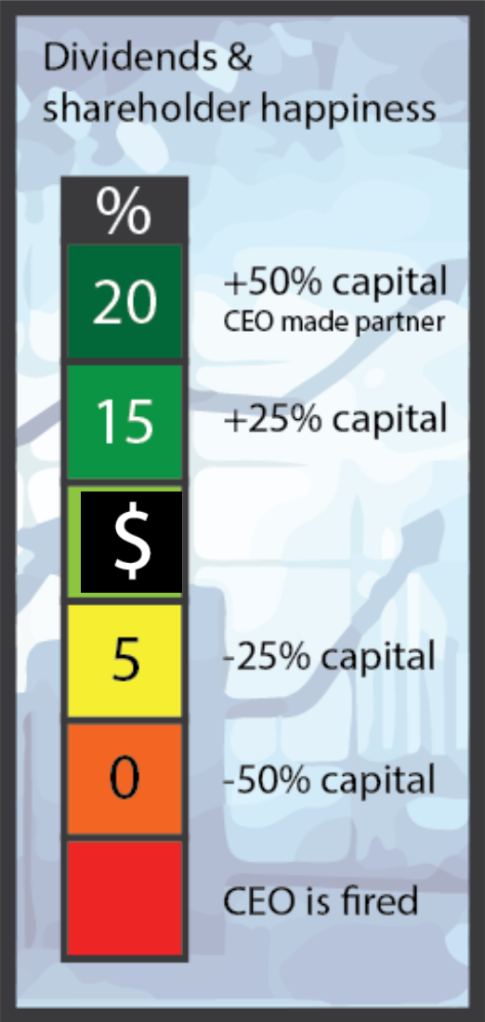The previous post gave a rough description of the population boards, and in this post we’ll have a look at the companies, all but one of which are involved in making sure the population has all the energy they need (and can pay for). This part of the game changed quite a bit between versions: the overall structure of the version used for Playtest 1 was based on models of the energy systems and divided companies into either producers or distributors of energy (two and three companies, respectively). As most of the energy used in the region is imported, this structure worked reasonably well for fossil fuel, biofuel, and electricity; for waste-to-energy, however, this was much too detailed, as what is in reality a single company working closely with the local authorities’ waste management department became two companies, one producer and one distributor. Thus, these two were merged for Playtest 2, and may even be merged with the waste collection department in the next version.


Also, during Playtest 1 one member of the Control team noticed that many of the players wanted to talk to someone in charge of the ‘general industry’ board which I had placed on the sidelines as I did not at the time see them as directly involved in the energy system. For Playtest 2, I constructed a proper role and board for the export-oriented industry (called ‘Regional industries’ in the game) and gave them the role as the major employer in the region – the idea was that the population players, whose wages are paid for mostly by the export industry, would quickly notice when the export market began to fluctuate. This did not happen during the playtest due to time and scenario constraints, and so this connection will have to be tested in a future version.
The company boards are to be relatively straightforward: raw materials/energy is bought and then used in various types of building to make products/other types of energy, which are then sold to other players (or the market, in the case of Regional industries). Although this seems rather simple, I’ve found it to be rather difficult to implement in the game in a way that is easy to quickly understand for the players. This is partly because I’ve limited myself to using A3 boards – which are too small for the amount of cards and tokens stacked on them for some companies – but mostly because I’ve avoided going into designing game parts describing very detailed production/conversion mechanics, as this is to be a game that deals with the overall development of society rather than finetuning of specific mechanics: in short, more Diplomacy than Agricola.


For Playtest 2, all companies were designed with three roles: CEO, salesperson, and operations manager. The CEO would be managing overall strategy and shareholders, the salesperson agreements to purchase the company’s products, and the operations manager purchase of raw materials/energy and the production/distribution buildings and their maintenance. As there were two players per team, they mostly took on all roles simultaneously and so this part of the system is relatively untested. An idea for next version is to expand the board horizontally so as to separate financials/shareholder happiness, available products/sales contracts, and production/maintenance, making for a more organized game experience.


Perhaps the most interesting part of the company boards in Playtest 2 was the profit/loss system as a motivator for CEOs to use the company’s money to keep shareholders happy rather than spending all on altruistic initiatives and blue-sky research. This has been a problem in other games I’ve constructed, and the share price track used in Playtest 1 was mostly ignored, likely because it didn’t do anything to the company, only to the final score of a single player in a game that is seen as being won by all players collectively (saving the world) or at least the team. The system used in Playtest 2 was confusing to get into, but at the end of Turn 2 was very noticeable – huge sums were paid in dividends and the companies that didn’t manage to were severely hampered (and very susceptible to invitations to use ‘creative bookkeeping’ to dip into next round’s earnings to pay for dividends this turn). A slightly modified version of this system will be used for coming playtests and the rules written down for CEO to study beforehand, so as to make it easier for them to plan ahead and set aside part of the profits to get ahead in the game of having enough money to spend on making changes.
A very interesting observation is that none of the players objected to this ever-growing-profit system, and only one company tried to plead with their shareholders using a promising plan for reusing waste as raw materials to keep them happy without having to pay steep dividends. In degrowth scenarios this will probably come to a point where companies need to choose between paying off their entire share capital with locally raised funds or going bankrupt, which will be interesting to see. It will also be interesting to see a game in which population players become aware of and begin questioning the system as it enriches some of them, but drains quite a lot of money that could have been used to aid in transitioning to a sustainable society.
In the next post I’ll be covering the local authorities boards and the waste management system, among other things.
